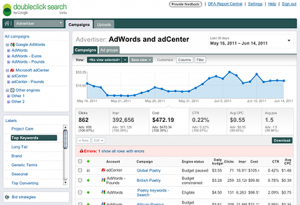Is Google’s Doubleclick Trying To Squash Search Technology Providers?
Since no analytics provider seems to have invented the perfect system to meet every need, we’re seeing an increasing number of advertisers using multiple systems together in order capture a wider set of data for reporting and optimization purposes. This is generally some combination of a search/display/Facebook technology provider and one or more analytics systems […]
Since no analytics provider seems to have invented the perfect system to meet every need, we’re seeing an increasing number of advertisers using multiple systems together in order capture a wider set of data for reporting and optimization purposes.
This is generally some combination of a search/display/Facebook technology provider and one or more analytics systems such as Google Analytics, Omniture, Web Trends, or Doubleclick.
Each system requires some combination of dynamic parameters or URL redirects to capture the necessary data about a click and/or conversion, so there’s a science behind getting all the systems involved to work harmoniously.
Multiple systems can function together if the following criteria are met:
- Custom parameters can flow through one system either onto the landing page or reports can be generated including custom parameters and imported into another system.
- URLs do not require redirects; or if a URL requires redirects, it does not have to be the first redirect.
Analytics & Redirects
For reference, below is an example URL using multiple redirects. The first redirect is in normal font, and the second redirect is italicized at the end. Note that the second redirect is URL encoded within the first:
https://akatracking.esearchvision.com/esi/redirect2.html?esvstue=13133462492&esvt=4-GOUS{ifsearch:E}{ifcontent:C}543&esvq={keyword}&esvadt=939929-1-10-1&esvcrea={creative}&esvplace={placement}&transferparams=1&esvaid=41662&useesvcid=1&esvcid_fwdsize=L&url=
http%3A%2F%2Fclickserve.us2.dartsearch.net%2Flink%2Fclick%3Flid%3D430000048238949
URL redirects present a very interesting issue. Information from the original source of traffic can only be associated with the first redirect in a string of redirects.
This is because once a URL has been redirected, the URL itself changes and the information from the referring domain (ex: google.com after a search has been executed – https://www.google.com/search?sourceid=chrome&ie=UTF-8&q=mens+shoes&utm_source=google&utm_medium=cpc) is no longer there.
If an advertiser is using multiple redirects (one redirect wraps another as in the example above) the second redirect cannot capture any information from the original traffic source. This greatly limits the capabilities of the second redirect.
Doubleclick Search 3
Historically, analytics systems have not attempted to block an advertiser from using other systems by requiring their redirect to be first.
This works because an analytics system use URL parameters to capture their data and do not require a redirect.
However, Google, with the release of Doubleclick Search 3, is preparing to do just that. In a recent conversation with the Doubleclick team, they indicated that DS3 must be the first redirect.
This is because DS3 utilizes a bi-directional synchronization system which overwrites unrecognized URLs in the search engine platforms.
This is a very useful feature used to ensure tracking is correct for their system, however, by requiring it to be used, Doubleclick is forcibly limiting an advertisers ability to utilize other tools in conjunction with Doubleclick Search.
This puts an advertiser currently using Doubleclick and other technologies in a tough situation. In some cases, the advertiser will have to choose between using Doubleclick Search and the other technology providers if the other provider requires a URL redirect.
Doubleclick seems to believe, with the DS3 release, it can compete with the major search technology providers and strongarm them out of the space. It’s an aggressive move and will force more nimble startups to get crafty and utilize URL parameters to capture all the data previously only generated using a redirect.
At this point, it’s worth asking why advertisers use Doubleclick in the first place. Advertisers use Doubleclick because it is an ad server tied into an analytics package.
Running multiple advertising channels through one system allows an advertiser to mitigate double counting conversions: a common phenomenon when using multiple tracking systems (technology provider with proprietary tracking and an analytics system).
That said, from a functionality standpoint, Doubleclick Search and DART for Advertisers (DFA) are definitely not the most advanced systems available save for specific features, such as the universal floodlight tag.
If you are using DS3 we’re very interested to hear feedback on the new platform – is it all it’s being hyped up to be? Since it’s not an inexpensive system to use, it better be good.
Contributing authors are invited to create content for Search Engine Land and are chosen for their expertise and contribution to the search community. Our contributors work under the oversight of the editorial staff and contributions are checked for quality and relevance to our readers. The opinions they express are their own.
Related stories
New on Search Engine Land
